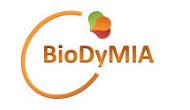2019 (10) " Investigation of interactions between exopolysaccharides produced by lactic acid bacteria and a bacteriocin or a bacterial toxin"(by Mojtaba AZARI ANPAR)
•Thesis direction :
Pascal Degraeve, Farideh TATABATAEI YAZDI ( Ferdowsi University of Mashad (Iran))
• Doctoral school :
EDISSPolysaccharides water holding, thickening or gelling properties condition the texture of many foods. During the last decade, exopolysaccharides (EPS) from lactic acid bacteria (LAB) have attracted more interest, since they can be produced in situ in foods, unlike plant or algal polysaccharides (e. g. pectin or sodium alginate, respectively). In the context of the « clean label » trend, LAB can be listed as ferments in the list of food ingredients, unlike pectin or sodium alginate, which are food additives. While many studies dealt with the techno-functional properties of LAB EPS resulting from their interaction with water and the other main food constituents, investigations of LAB EPS interactions with bioactive molecules are scarce. Therefore, the goal of the present study was to investigate interactions between a set of polysaccharides, including LAB EPS, and either nisin Z, an antibacterial peptide produced by Lactococcus lactis subsp. lactis, or Escherichia coli heat-labile enterotoxin B-pentamer (LTB). Indeed, E. coli heat-labile enterotoxin is a protein composed of a single catalytically active A subunit and a non-toxic pentameric B subunit, that mediates receptor interaction and uptake of the toxin by target cells. The set of EPS comprised (i) low (9-11 kDa) and medium (60-76 kDa) molecular weight dextrans from Leuconostoc mesenteroides, EPS from Ln. mesenteroides P35 strain, and 2 kefirans (extracted from milk kefir grains launched by Crokfun or Kefiralia). Elucidation of Ln. mesenteroides P35 EPS structure revealed that it is a high molecular weight dextran (estimated Mw of 9.9 × 103 kDa) with 90 % α-(1→6) linkages and 10% α-(1→3) branch linkages between glucose units, while both kefirans were heteropolysaccharides consisting of glucose and galactose. Investigation of the effect of each EPS and of either highly methoxylated citrus pectin, or sodium alginate (added at a 1g.L-1 concentration in tryptic soy broth) on nisin Z antibacterial activity revealed that only sodium alginate decreased its antibacterial activity (i. e. 4-fold increase of minimal inhibitory and bactericidal concentrations against Listeria innocua ATCC 33090 and Kocuria rhizophila ATCC 9341). Following zeta potential determination at pH 7 of nisin Z, of bacteria and of polysaccharides, only nisin Z had a slightly positive zeta potential, while bacteria, sodium alginate, and citrus pectin zeta potentials were lower than -20 mV, and zeta potentials of EPS were all between 0 and - 10 mV. It is thus proposed that anionic sodium alginate, which is the only polysaccharide having a lower zeta potential than both bacteria, forms complexes stabilized by electrostatic interactions with oppositely charged nisin Z, thereby decreasing the quantity of “free” nisin Z interacting with nisin-susceptible bacteria. This hypothesis was substantiated by the observation of nisin Z - sodium alginate aggregation at pH 7 and estimation of the apparent affinity of sodium alginate for “free” nisin Z and immobilized nisin Z by surface plasmon resonance (SPR). Similarly to nisin Z, LTB was immobilized by amine coupling on an amine carboxymethyl dextran sensor chip, thereby allowing the monitoring of its interactions with polysaccharides by SPR at different temperatures. SPR analysis revealed the high apparent affinity of Ln. mesenteroides P35 EPS for immobilized LTB (KAapp=(2.05 ± 0.04) ×106 mol.L-1 at 37°C). The binding process was spontaneous (ΔG<0), endothermic (ΔH>0), and entropy-driven (ΔS>0) with an increase of KAapp with temperature. This suggests that EPS - LTB interaction is dominated by hydrophobic forces. In silico analysis by molecular docking of interactions between LTB and Ln. mesenteroides P35 EPS allowed to precise the putative molecular interactions involved. This suggested that some LAB EPS, such as Ln. mesenteroides P35 EPS are good candidates to inhibit E. coli thermolabile enterotoxin activity. This should now be further investigated.



 fr
fr en
en